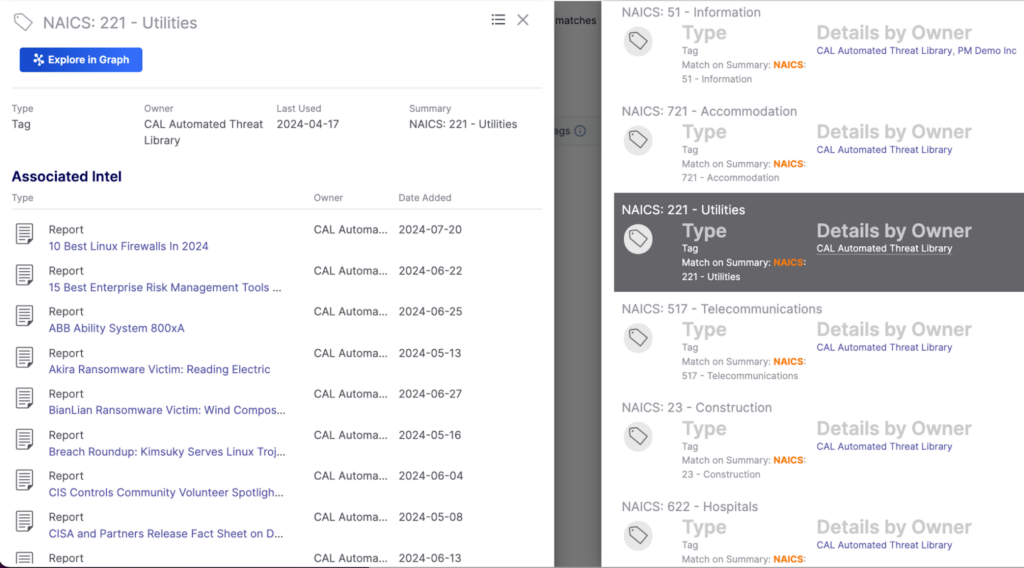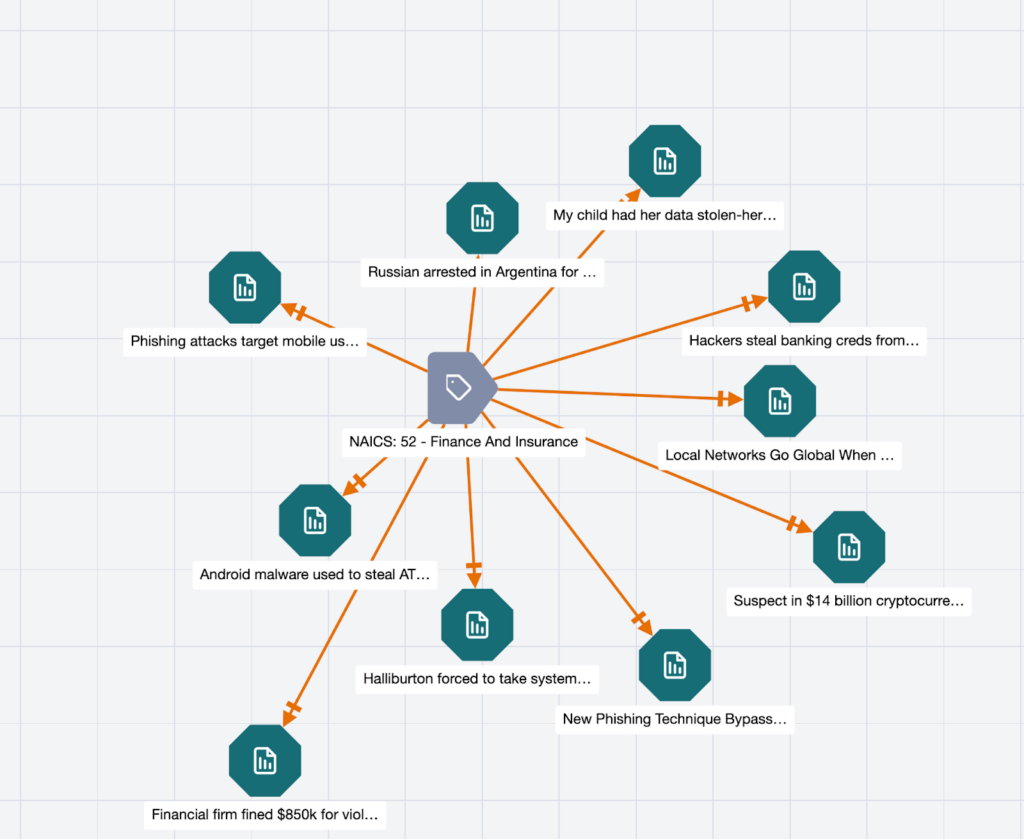Posted
Enhancing Cybersecurity with CAL™ Automated Threat Library (ATL) Industry Classification.
In the constantly changing field of cybersecurity, it is crucial to effectively manage and interpret large volumes of open-source intelligence (OSINT). ThreatConnect’s CAL™ Automated Threat Library (ATL) addresses this challenge by using natural language processing (NLP) to classify ATL Reports by industry using NAICS codes*. This classification, available through standard tags and keyword suggestions, significantly improves threat detection, intelligence requirements (IRs), and decision-making within the ThreatConnect platform.
*North American Industry Classification System
Streamlining Cybersecurity with Industry Classification
The CAL ATL industry classification system efficiently organizes large volumes of OSINT into machine-readable components. Users can quickly filter and focus on relevant intelligence by applying industry-specific tags to ThreatConnect objects like Groups. This functionality aids in building precise IRs and facilitates searching and browsing within the platform.
The Role of NAICS Codes in Threat Intelligence
Integrating NAICS codes addresses the critical problem of effectively categorizing and prioritizing OSINT. With the vast amount of data generated daily, analysts often need help determining which threats are most relevant to their specific industry. NAICS codes provide a standardized method to classify this data, enabling more efficient filtering and focus on industry-specific threats.
Leveraging a classification system like NAICS allows customers to scope their interest between a broad sector and a specific subsector, letting them be as broad or specific as they want for their purposes. This precise classification allows for faster response times, better resource allocation, and improved overall security posture by promptly addressing the most pertinent threats.

Navigating the Complexities of Industry Classification
Classifying content by industry is a challenging task due to several factors. One significant complexity is the overlap between categories when discussing industries in broad terms. For instance, technology and IT often intersect, making it difficult to draw clear boundaries.
The dynamic nature of industries adds another layer of complexity. As industries evolve and terminology changes, what once fit into one category may shift into another. A prime example is the publishing industry, which used to include software publishing when software was distributed on physical disks.
Granularity levels also play a crucial role in classification. While some classifications may group everything under broad categories like technology, others might differentiate between specific sectors such as microchips or IT services.
Localization further complicates the picture, as different countries have groupings and standards. For example, a company classified under one industry in the U.S. might fall under a different category in Europe or Asia.
Moreover, various taxonomies exist for classifying industries, each with its own criteria and focus. Some of the most notable ones include the North American Industry Classification System (NAICS), International Standard Industrial Classification of All Economic Activities (ISIC), Global Industry Classification Standard (GICS), European Union NACE, Australian and New Zealand Standard Industrial Classification (ANZSIC), Japan Standard Industrial Classification (JSIC), and the UK Standard Industrial Classification of Economic Activities (UK SIC).
Understanding and navigating these complexities is essential for accurate and effective industry classification.
Industry-Specific Tagging Using NLP
CAL ATL employs NLP to analyze ATL Reports and associates them with relevant NAICS codes. These tags, covering a broad range of industries from agriculture to public administration, enable users to make quick decisions on selecting or excluding ATL resources, focusing on high-priority tasks.
Practical Applications
- CAL ATL Report Groups and Tags: Users can pivot on tags to explore related reports within the platform. For instance, viewing an industry tag in a report’s details screen reveals all associated reports, enhancing threat intelligence connections.
- Intelligence Requirements: When creating IRs, users can include or exclude NAICS keyword suggestions, ensuring their intelligence gathering aligns with a broad sector or specific industry needs. This targeted approach enhances the relevance and accuracy of IR results.

Use Case: Protecting Financial Institutions
Consider a financial institution that must protect against threats specific to the banking sector. With CAL ATL’s industry classification, the institution can tag incoming OSINT with the relevant NAICS codes, such as those for banking and finance. This allows analysts to quickly filter and identify threats to their sector, such as phishing schemes targeting bank customers or malware designed to infiltrate financial systems.
The institution can prioritize its resources, implement targeted defenses, and respond swiftly to emerging threats by focusing on industry-specific intelligence. This use case illustrates how CAL ATL’s industry classification system enhances the ability to detect, triage, and mitigate threats within a specific sector, ultimately bolstering the institution’s cybersecurity posture. CAL ATL’s industry classification also helps organizations gain perspective on strategic intelligence within an industry sector so they can also pivot resources and investments to meet a changing security landscape.
Enhancing Threat Intelligence with NAICS Codes
Integrating NAICS codes into the CAL ATL framework streamlines cybersecurity efforts by categorizing intelligence reports into industry sectors and subsectors. This detailed classification supports targeted threat detection, alert triage, and response strategies, empowering organizations to focus on industry-specific threats and vulnerabilities.
ThreatConnect’s CAL ATL industry classification, powered by NLP and NAICS codes, revolutionizes the management of OSINT. Organizing intelligence into industry-specific tags and keywords facilitates more efficient threat detection, response, and threat hunting. This robust classification system ensures organizations can leverage precise, relevant intelligence to bolster their cybersecurity defenses.
Want to Learn More?
We offer various ways to learn more about the ThreatConnect TI Ops Platform: Take an interactive tour, check out our website, or request a demo to learn how ThreatConnect can help you operationalize your threat intel program.

